When you’re living out in the wild, starch is one of the hardest things to come by, and it’s one of the best ways to feel full. It’s made up of sugars that you need for energy, and when it’s not being used, it’s stored in the body as fat. This gives you reserves that you can use later when you need it, which is very helpful when you’re having a bad stroke of luck in finding food.
[the_ad_placement id=”in-text-1-type-r”]But did you know that there’s an extremely common source of starch lying right at your feet almost every fall? It’s acorns! If squirrels can eat them, why can’t you? You’ve probably asked the question “can you eat acorns” and you would be somewhat right.
Ways to use acorns
There are three main methods in using acorns:
- collecting them as nuts right off the ground,
- making acorn flour,
- cooking in acorn oil.
Collecting acorns is probably the easiest part of the process, as all you need to do is find any oak tree in your area and look at the ground. The best ones would have already fallen off and are ripe for the taking. The best time to find an abundance of acorns is between September and early spring and this covers the wide varieties of oaks that may exist in your area, as some shed later than others.
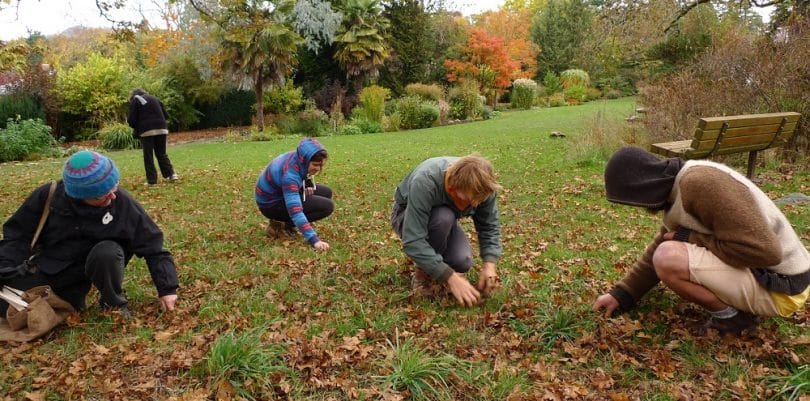
So, always be on the lookout for fresh acorns so that you have an abundant supply. Even if you do find some acorns that have sprouts between one to two inches long, they’re still good to be eaten as long as you discard any meat that has started to turn green.
One thing you should look for when gathering your acorns is holes. If there is already the presence of small holes in the shells, then they’re already infected with the larva of the oak weevil and you should discard them immediately. You don’t want to eat these.
Knowing your oak trees well will help you determine how the acorns you’ve picked can be cooked and eaten. Take leaf samples in May as well as acorns and compare them to images online so that you know the kind of oak trees in your area. This is important, as this can tell you the level of tannins that is in your acorn.
For example, acorns that are low in tannins can even be eaten raw. So if you’ve been asking yourself “can you eat acorns raw”, then the answer is yes, depending on the type. It will also tell you what each acorn type is good for, as they come in quite a wide range of properties.
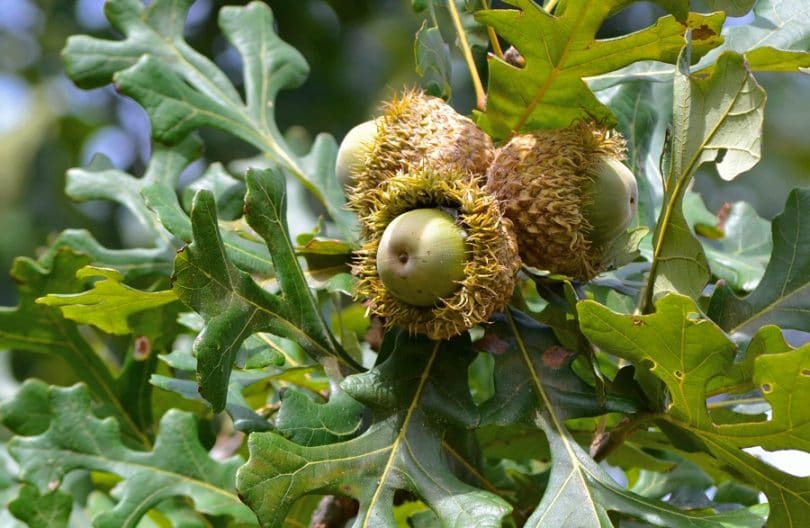
For example, in terms of fat content, acorns can range anywhere from 1.1% to 31.3%; protein can be 2.3% to 8.6%; carbohydrates can be 32.7% to 89.7%. Those are extremely wide ranges that provide multiple uses for different kinds of acorns. A fattier acorn is better at making a meal like ground almonds, while an acorn rich in carbohydrates will make drier flour.
Kinds of oaks to look for
If you’re looking for the “sweetest” acorns (this means that they have the lowest level of tannins and can be eaten raw), then you want to look out for these kinds of oak trees:
- East Coast White oak
- Emory oak
- Pin oak
- Valley oak
- Blue oak
- Burr oak
- Cork oak
- Bellota oak
If finding the largest acorns are what you’re leaning towards, then you want to look for:
- Valley oak
- East Coast White oak
- Burr oak
- California Black oak
For acorns that have a high fat content, then you want to find:
- Eastern red oak
- Live oak
- Coastal oak
- Interior live oak
- Tan oak
- Black oak
How to shell acorns
It seems that acorns are extremely tough, making you question are acorns edible in the first place. After all, they fall hundreds of feet to the hard ground and still can’t be cracked open. But there’s a secret to getting these acorns open, and once you learn how, you’ll marvel at how easy it is.
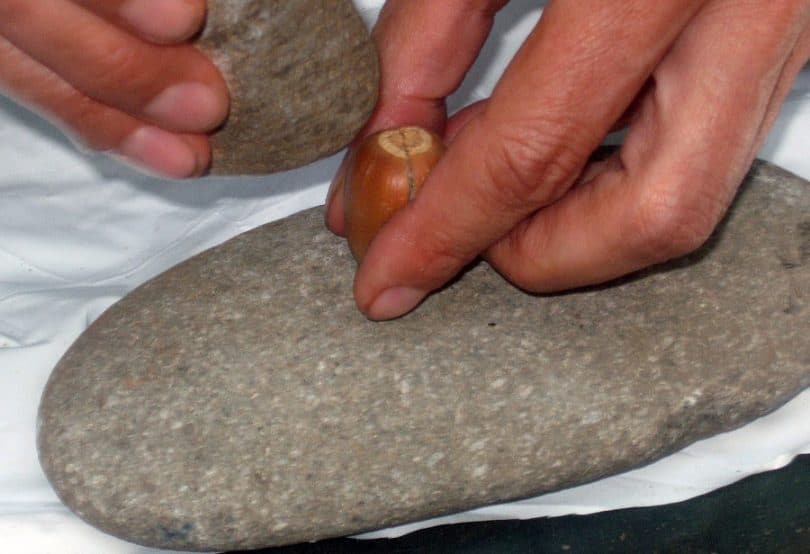
The shelling of acorns will probably be the most time-consuming part of the process, but you’ll be handsomely rewarded in the end for it. Their shells are a bit elastic that are quite resistant to any normal kind of nut cracker.
So the best thing to use is a hammer. First, if there’s a cap still on your acorn, remove it. Then place this flat end down on a hard surface and hit the point end of the acorn with your hammer. Be careful with hitting it, as your hammer can easily slip and get your fingers instead. For extremely pointy acotns, like the cork oak and Valley oak, hit the side of the acorn instead.
[the_ad_placement id=”in-text-2-type-r”]This process is much easier if you choose to dry your acorns instead, as the shell becomes a little more brittle and easier to crack. The best way to dry them is to put your acorns in shallow pans to dry so that they don’t start to get moldy. Even the oldest of acorns will be easy to crack when they’ve been dried for a bit.
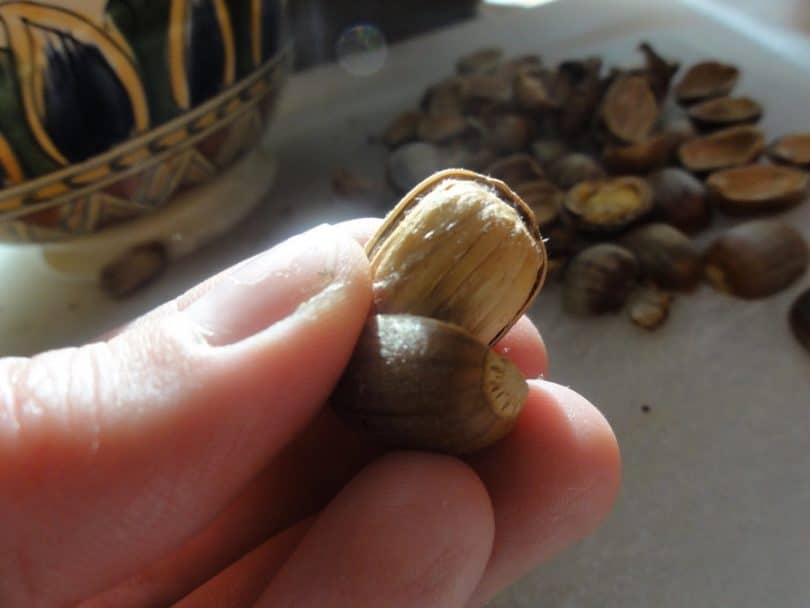
If you’re deciding to make flour, then the breed of your acorn matters. Red oak acorns seem to have a skin that doesn’t want to come off, so they should be boiled first. This skin can be a bit bitter, so boiling it to remove this will definitely improve the flavor of your flour. They should be boiled a handful at a time, as allowing them to cool in between shellings will make the skin hard again. With other kinds of acorn, you want to shell them in water, as this helps the meat to oxidize faster and give your acorn flour a much lighter color.
Removing the tannins
Tannins are the bitter substance in plants that make acorns taste pretty bad. Tannins can also make you feel nauseous as well as constipated for a few days, so it’s best to get rid of it before you start eating acorns. You can do this through the simple process of boiling. The acorns can be dropped directly into a pot of boiling water, and then it should be changed once the water gets dark. This is the tannins being leeched out so that the acorns can be safer to eat.
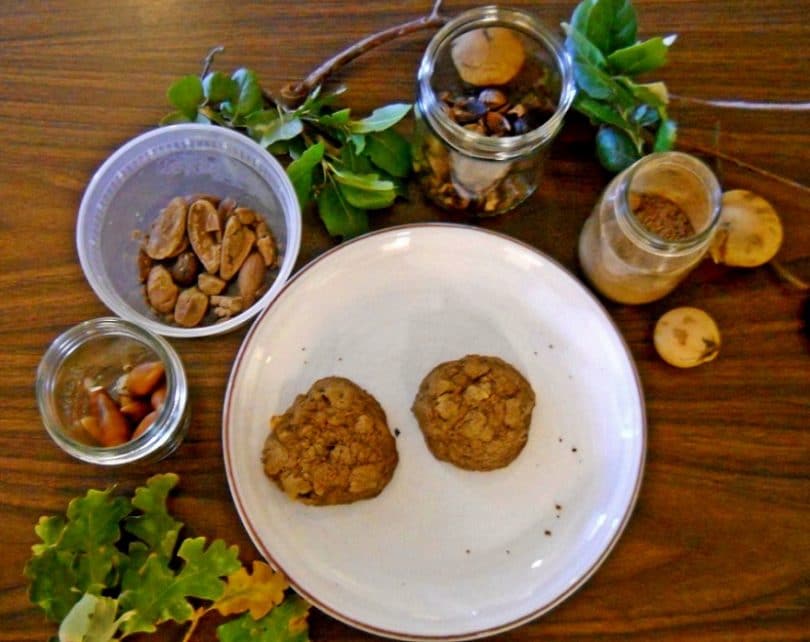
Depending on the kind of acorn, you’ll have to change the water between three to five times for the majority of the tannins to be removed. If you want the least amount of changes, then choose acorns from the “sweet” list mentioned above.
Here’s a helpful video detailing the process of preparing acorns for eating:
Once they’re free, you’ll need to dry them quickly or they will start to rot. You can do this by using a tea towel and patting them down or spreading them out onto a cookie sheet and leaving them in the sun to dry. Roasting them in the oven works quite well too. If you have already prepared your acorn meal, then they should be kept in jars in the fridge, as the fat content in the acorns will start to go bad pretty quickly if they are kept at room temperature.
An alternative method for leeching out the tannins requires no heat at all, but will take much longer. The acorns should be ground into flour first and then placed in a dry, non-reactive container. Mix one cup of water for every three cups of flour and then place in a fridge or cold place. Shake the container every day for at least one to two weeks, wait an additional twelve hours, and then pour off the water and the tannins. This is known as cold leeching, and is good for making acorn flour that you can use in baked goods.
A good video detailing this process can be seen above.
Making acorn flour
If you want to make acorn flour to use in baking, then you’re going to have to prepare them properly. What you’ll need are at least a gallon of acorns, cooking sheets or a dehydrator, something to break the nuts with (nutcracker, mallet, or a hammer), a flourmill, cornmeal grinder or potato masher, and a sifter.
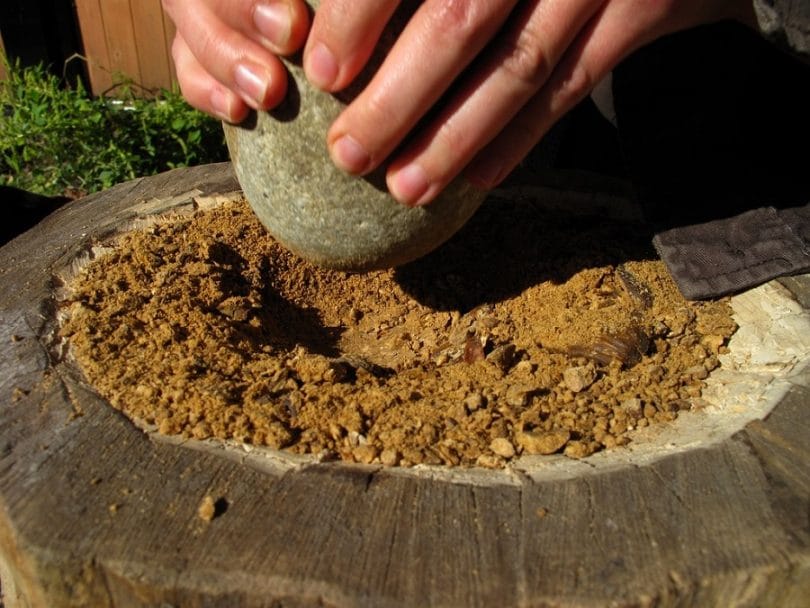
Prepare the acorns as you’d usually do with boiling them until the tannins have been removed. Then mash them with your mallet or hammer until they’re in smaller pieces. You want to have the shells and skin separated from the meat of the acorn so that they don’t alter the taste of your flour. Then use your potato masher or grinder while they’re still wet so that you can get a powdery texture.
You want to crush the pieces as fine as possible in order to get the most out of your acorns. Spread the flour across the cookie sheets and leave to dry in the sun or in your dehydrator. Once it’s dry you may want to put it through a food processor again to ensure that it’s as fine as you can get it before sifting it. This removes any grits that may remain. Store your flour in an airtight container in a dark, dry cupboard or in the fridge.
Making acorn oil
Pressing acorns for oil may seem like an impossible task, but it can be done. The oil makes up almost a third of the weight of the acorn, and can be used for a variety of purposes. However, one of those isn’t eating. Hunters have been using acorn oil to attract animals as well as mask their own scent in the woods.
Here’s a video detailing further uses for acorn oil:
Check all the above YouTube videos for useful tips.
Other ways to eat acorns
If you’re wondering if there are other ways to make acorns edible, then you’ve come to the right place. Due to their versatility, once they’re processed, acorns can be used in a lot of things, like:
- Acorn brittle: all you have to do is follow any peanut brittle recipe and replaced the peanuts with processed acorns. Then simply let it cool, and you have a delicious healthy snack that you can take with you anywhere. Having this prepared beforehand can provide you the boost of energy that you need when you’re starting to feel rundown.
- Acorn bread: while drying your leeched acorns, wait until they are halfway between dry and wet and run them through the blender, grain mill, or grind them between two rocks. Leave the flour to air dry for a few hours in the sun and then grind it again to make sure the flour is fine. Then use any bread recipe you may know. It won’t be as soft and spongy as wheat flour, and will tend to be more crumbly.
- Acorn cookies: after making acorn flour, you can try your hand at making these delicious cookies by exchanging your wheat flour for acorn flour. You’ll need three cups of acorn flour, 1/2 teaspoon of baking soda, 1/2 teaspoon of salt, two eggs, two teaspoons of vanilla extract, one cup of white sugar, one cup of butter, one cup of brown sugar, and one cup of peanut butter.
Mix the flour, salt and baking soda together in one bowl, and then the softened butter and peanut butter in another bowl. Add vanilla and the sugars to the butter mixture and mix well until blended. Add the eggs, mix again, and then stir in the flour mixture until smooth. Roll the dough into balls and pat onto an ungreased baking pan and bake for ten minutes at 375 degrees or until they start to turn a light brown. This recipe makes about 48 to 60 cookies. - Acorn coffee: this isn’t going to have the same caffeine kick as coffee, but it can serve as a coffee substitute if you’re looking for something that tastes similar. Roast your leeched acorns in the over for thirty minutes at 400 degree until they are dark brown. Then add one teaspoon of roasted acorn to an eight ounce cup of boiling water and steep for about five to ten minutes. You can choose to add milk and sugar, or drink it black. Above is a quick video showing how to make acorn coffee.
To be more sustainable, read our article on how to build your own greenhouse to learn more.
Dietary benefits of eating acorns
Acorns provide a lot of health benefits that people probably weren’t aware of before. Like most nuts, they’re quite a dense food, which means that you’ll feel fuller for longer. They’re not as high in fat as some other nuts, but they do have rich carbohydrate content, as well as vitamins and minerals.
[the_ad_placement id=”in-text-3-type-r”]The properties of acorns have even been shown to help control blood sugar levels, which is great for those who are suffering from or are prone to diabetes. If you have a green thumb, our article on ways to propagate mushrooms is loaded with information you can use, so check it out.
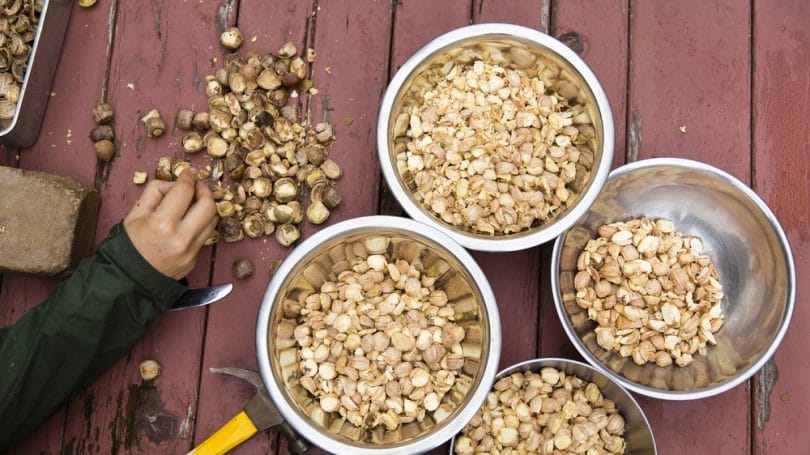
Acorns definitely have more use than we give them credit for, and now you know the question to can you eat acorns. It does take a lot of patience to get the most out of these hardy nuts, but there’s no reason to simply throw them away when you probably have them in the plentiful in your backyard.
In fact, you may have more than what you know to do with, so why not start putting these nuts to good use and including them in your diet? Maybe the lack of them will keep the squirrels out of your yard for once, now that you’re taking their food supply instead.
Want to learn more? See our must-read article listing the wild plants you can eat as food for survival.






An interesting thing to know about the acorn food prep process is that the tannic water you get from boiling the acorns to leach the tannin has a variety of uses because it is antiviral and antiseptic. It is helpful as a wash for burns, abrasions, skin irritations, and poison ivy skin rashes. It can also be used as a gargle.
Acorns formed the staff of life, the basis of nearly every meal for Bay Area Indians. Therefore, they are ideal as well as interesting food choice and medication.
This is one of the most useful survivalist info I’ve learned. The book, “A Sanctuary of Trees” by Gene Logsdon also mentioned that the Chinquapin Oak (part of the white oak group) produces sweet, palatable acorns that have a low amount of tannin. Another fun fact about acorns as food is that during World War II Japanese school children were given the task of collecting tons of acorns to help feed the country when rice and flour supplies became scarce.
Acorns contain large amounts of protein, carbohydrates, and fats, along with calcium, phosphorus, and potassium. They are a good food choice, especially in a survival situation.
I’ve been wanting to try my hand at making acorn flour or using acorns in a meal for a while now. There are millions of acorns around where I camp, but I’ve always been put off by how much hard work it is to gather and prepare them, however, in a survival situation, I guess that won’t be too much of an issue. Some really useful tips, thanks!
Regardless of the hard work required for gathering and preparing acorns, they are highly nutritious especially during an emergency.